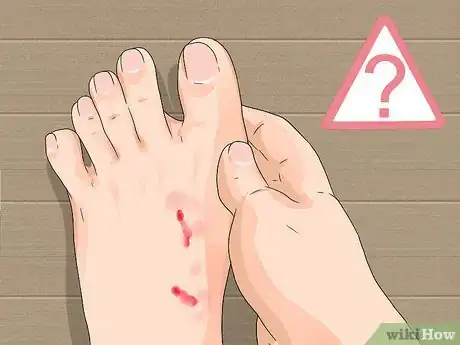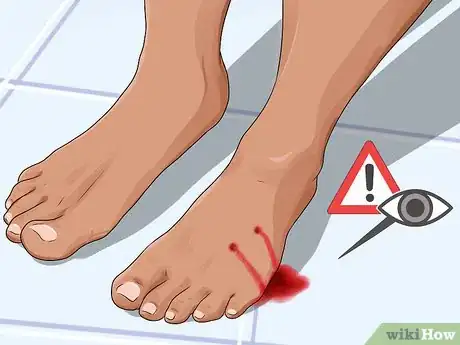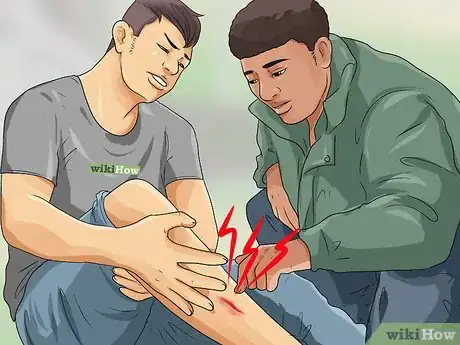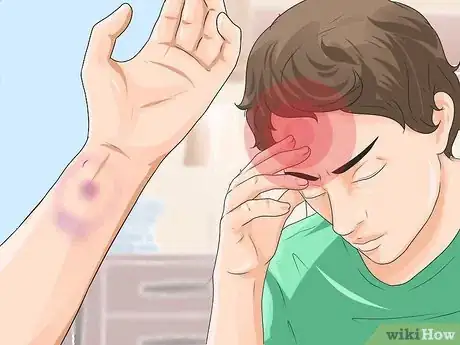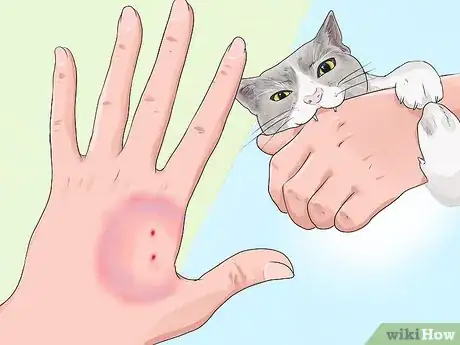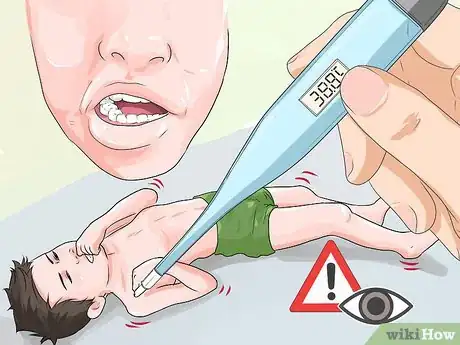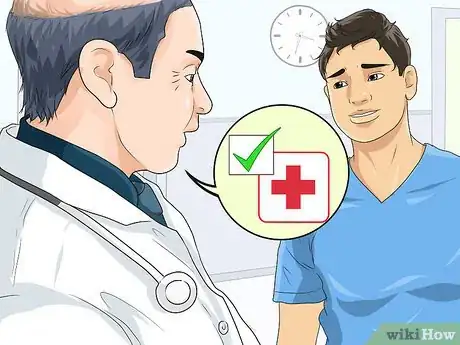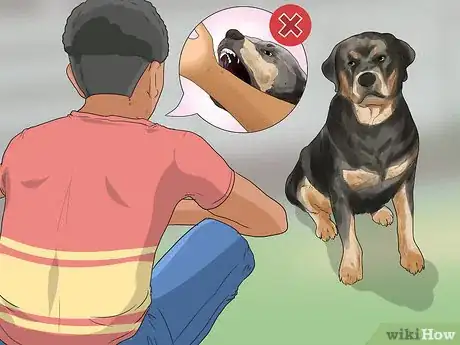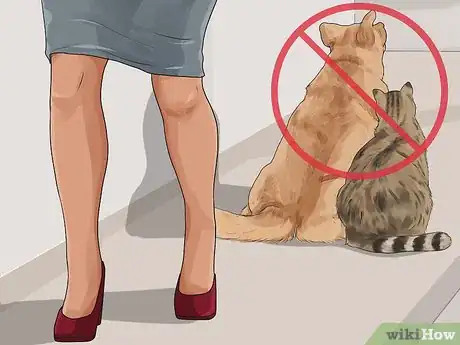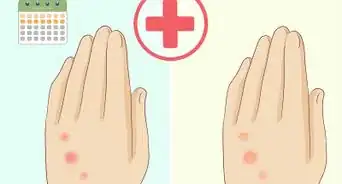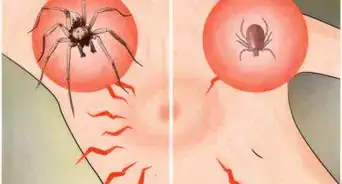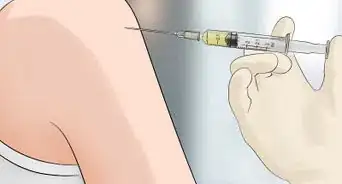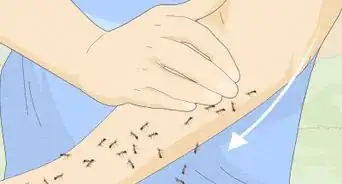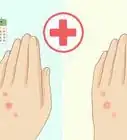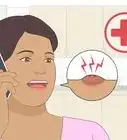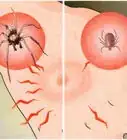This article was medically reviewed by Erik Kramer, DO, MPH. Dr. Erik Kramer is a Board-Certified Primary Care Physician at the University of Colorado. With over 15 years of experience, his clinical interests include obesity and weight management, diabetes care, and preventive care, as well as embracing a holistic approach to primary care. He received his Doctorate in Osteopathic Medicine (D.O.) from the Touro University Nevada College of Osteopathic Medicine and completed his residency at Central Maine Medical Center. Dr. Kramer is a Diplomate of the American Board of Obesity Medicine.
There are 16 references cited in this article, which can be found at the bottom of the page.
This article has been viewed 174,943 times.
Pets may bite when they are stressed, when they are left with unfamiliar people or in unfamiliar places, or when they are not being handled properly. Many pet bites are minor injuries that can be treated at home, but any pet bite requires immediate treatment. Even if you don’t think the bite is serious, you should still call a doctor for advice.[1] To tell if a pet bite is serious, look for immediate trauma signs such as a potentially venomous bite and rapid blood loss, as well as signs of infection, tetanus, and rabies. If you do not know if a pet bite is or may become serious, seek medical assistance as soon as possible.
Steps
Checking for Immediate Trauma
-
1Determine the severity of the bite. Look at the bite to evaluate how severe the victim's condition is. Check for signs such as bruising, punctured skin, bleeding, and objects stuck in the wound. The more severe the bruising or bleeding looks, the worse the bite is.[2]
- A bite that shows only minor scratching and irritation to the skin is likely not serious. It should be cleaned with soap and warm water and monitored as it heals, but likely will not need medical attention.
- A severe bite that may need additional attention will include either rapid heavy bruising of unbroken skin, heavy or uncontrollable bleeding of broken skin, multiple punctures to the skin, or an object such as a tooth stuck in the skin.
-
2Identify the type of animal. If possible, try to quickly identify the type of animal that caused the bite. Naturally venomous reptiles, amphibians, and arachnids may or may not be de-fanged, and dogs with strong jaws such as pitbulls and rottweilers may be able to cause greater immediate injury.[3]
- If the pet was not yours, ask the owner what type of animal the pet was, down to the species or breed.
- If you don’t know if a certain type of exotic pet is venomous, quickly search online or call a local vet’s office to see if they have any more information.
Advertisement -
3Look for loss of blood. A little bleeding is common with many pet bites, but rapid or uncontrollable bleeding can quickly become problematic. Look at the bite site to see if blood is slowly pushing out of the injury, or if there is a fast flow or heavy squirts of blood.[4]
- Regardless of how much blood is being lost, try to stop excess blood flow by elevating the injury and applying pressure to the wound when possible. Use medical gauze or a towel to keep the blood from getting on others.
- If you notice blood loss, it is important to act quickly to slow the loss and seek medical attention. After you get the bleeding under control, you need to see a doctor right away. If you can’t stop the bleeding within 10 minutes, then call 911.[5] A loss of as little as 15 percent of a person’s blood can have negative side effects.[6]
-
4Evaluate pain levels. A pet bite that breaks the skin will likely cause some form of discomfort. However, extreme pain may be an indicator of problems under the surface such as hemorrhaging or a broken bone. Check with the bite victim to see if they feel any identifiable discomfort under the broken skin.[7]
- You may also test levels of pain by applying very gentle pressure to the affected area. If the bite victim has an extreme reaction to a normal touch, that may indicate trauma under the skin.
-
5Find any additional injuries. If the bite was accompanied by other force, such as the pet knocking the person down or pushing them into a wall, look for other potential injuries such as serious bruising, a concussion, or other breaks and tears in the skin. Even if the bite is not serious, accompanying injuries may be.[8]
- Additional injuries may be especially common when a larger animal such as a large-breed dog bites a child or an already injured individual.
- Signs of additional trauma may include pain or swelling at a point of impact, broken skin and/or bleeding, or heavy bruising on an impacted area.
-
6Seek immediate medical treatment. If you notice any signs of physical trauma, do not wait to see if more problems appear. Seek medical attention at a clinic or emergency room. Let the doctors know everything you can about the bite, including what type of animal caused it, when it happened, and any pain or symptoms that the bite victim has reported. You should seek emergency medical treatment if:
- the bite is from a severe attack.
- there is heavy bleeding.
- there is an injury to the face, eyes or scalp.
- the bite is from a stray pet or household pet that has not or may not have received rabies protection.[9]
Assessing Additional Risk Factors
-
1Ask about the pet’s rabies vaccination history. If the biting pet was not yours, ask the owners about the animal’s vaccination history. In particular, let them know, “I would like to see records of your pet’s last rabies vaccine, as well as any other vaccines they have had in the past year.”[10]
- If the owner refuses to provide you with this information, call your local animal control office and ask for assistance in acquiring the necessary information.
- If the biting pet was your pet, check their vet records to see if they are up to date on all of their vaccinations.
- If the pet does not have a current rabies vaccine, wash the wound with warm water and seek immediate medical attention from an emergency or urgent care facility.
- While most cases of rabies are caused by bats, raccoons, skunks, and foxes in the US, you should still check the pet’s vaccinations for any severe bite.
-
2Monitor for infection. Certain bites, such as bites from cats, are more likely to become infected. Monitor the wound closely for early signs of infection, which may include swelling, redness, or difficulty moving the bitten area.[11]
- If you think the bite is likely to become infected because of the particular animal or the conditions under which the bite happened, contact your doctor immediately and let them know, “I worry that this pet bite might become infected. Do you recommend any immediate medical attention?”
- Wash a bite with mild soap and warm water, apply antibiotic ointment, and dress it with a clean bandage immediately after receiving the bite to help reduce chances of infection.[12]
-
3Watch for signs of tetanus. Animal bites that break the skin may allow the bacteria that causes tetanus to enter into the body. If the bite victim has not had a recent tetanus booster within the last 5 years or is not immunized against the disease, immediate medical help should be sought.[13]
- Those who have been immunized should check with their general practitioner to ask about their most recent tetanus booster and see if their doctor recommends any additional preventative care at that time.
- Symptoms of tetanus, if left untreated, may appear in as little as four days and include jaw cramping, involuntary muscle stiffening, trouble swallowing, seizure, fevers, and an accelerated heart rate.[14]
-
4Seek a doctor’s opinion. If you have any concerns regarding a bite, even if it shows no immediate signs of trauma or infection, it can still be helpful to check with your doctor. Schedule an appointment as soon as possible and let them know that you want them to evaluate a pet bite.[15]
- Report any soreness, tenderness, or residual pain to the doctor. This could be an indicator that something was damaged under the skin.
- Let your doctor know what kind of animal bit you and how long ago the bite happened. Include any information you may have on the animal’s vaccination status.
- Ask your doctor, “What type of care or treatment do you recommend for this injury?” Follow any wound care routines and take any prescribed medications as instructed.
-
5Get immediate medical attention in certain situations. There are some situations where you should seek immediate medical attention for a bite no matter what. These situations include:
- Being bitten by a cat.
- Getting a bite from a dog to the hand or foot.
- Getting a bite that is deep, large, and/or that caused a laceration large enough to require stitches.
- Having a broken bone or internal injury.
- When a child has been bitten on the head.
- When there are signs of infection including redness, pus, swelling, and worsening pain.
- When the bite was sustained by a person with diabetes, cancer, liver, lung disease, AIDs or another condition causing a weakened immune system.[16]
Preventing Future Pet Bites
-
1Teach your pet not to bite. If your dog or cat was the one responsible for the bite, enroll in a training program or work with your pet at home to teach it not to bite. Often, many animal rescues and shelters have training programs for aggressive pets. Call and ask if their programs are open to pets from the community, as well.
- If you have a pet that is not easily trained, such as a snake, frog, or small mammal, make sure the pet is kept in proper housing with an effective locking mechanism.
- If you have a pet that requires certain equipment such as gloves to handle them, make sure to always use the equipment properly every time you handle your pet.
-
2Know the signs of an impending bite. Different types of animals have different signs that indicate they may be about to bite. Learn common signs of distress for typical pets such as dogs and cats to help identify potential bite risks.
- Signs a dog is about to bite may include snarling, barking, growling, ears back, aggressive tail-wagging, repeated stress yawning, and more.[17]
- Signs a cat is about to bite or scratch include increased stiffness in the body and a twitching of the tail. Cats are especially prone to bite during tummy rubs, as well.[18]
-
3Stay away from unfamiliar pets. If you do not know if a pet is friendly or not, err on the side of caution. Keep a safe distance from any pets you do not know until you’ve talked to their owners and have a better idea of the pet’s demeanour.
- When you want to approach a new pet for the first time, ask the owner, “Is it alright if I touch your pet? Does your pet have any temperament issues that I should be aware of while interacting with them?”
- Allow the pet owner to instruct you or demonstrate for you how to interact with their pet for the first time.
Warnings
- Even small pet bites can result in serious injury if not treated properly. If you have any questions or concerns, seek immediate medical attention.⧼thumbs_response⧽
References
- ↑ http://www.webmd.com/a-to-z-guides/wound-care-10/treating-human-and-animal-bites
- ↑ https://drsophiayin.com/blog/entry/was-it-just-a-little-bite-or-more-evaluating-bite-levels-in-dogs/
- ↑ http://www.nehumanesociety.org/community-services/animal-control/animal-bites.html
- ↑ http://www.medicaldaily.com/breaking-point-how-much-blood-can-human-body-lose-350792
- ↑ http://www.webmd.com/a-to-z-guides/wound-care-10/treating-human-and-animal-bites?page=2
- ↑ http://www.medicaldaily.com/breaking-point-how-much-blood-can-human-body-lose-350792
- ↑ http://www.medicinenet.com/dog_bite_treatment/page2.htm
- ↑ https://www.cdc.gov/traumaticbraininjury/symptoms.html
- ↑ http://www.webmd.com/a-to-z-guides/wound-care-10/treating-human-and-animal-bites?page=2
- ↑ http://www.hopkinsmedicine.org/healthlibrary/conditions/travel_medicine/animal_bites_and_rabies_85,p00819/
- ↑ http://www.vcahospitals.com/main/pet-health-information/article/animal-health/wounds-cat-bite-injuries-to-humans/63
- ↑ http://www.mayoclinic.org/first-aid/first-aid-animal-bites/basics/art-20056591
- ↑ http://www.mayoclinic.org/healthy-lifestyle/adult-health/in-depth/health-tip/art-20048960
- ↑ https://www.cdc.gov/tetanus/about/symptoms-complications.html
- ↑ http://www.humanillnesses.com/original/A-As/Animal-Bites.html
- ↑ http://www.webmd.com/a-to-z-guides/wound-care-10/treating-human-and-animal-bites?page=2
- ↑ http://dogtime.com/dog-health/dog-behavior/19137-advocacy-column-dog-bite-warning-signs
- ↑ http://www.vetstreet.com/our-pet-experts/me-ow-signs-your-cat-is-about-to-bite-or-scratch-you#0_g2w6teh4
About This Article
To know if a pet bite is serious, look for immediate signs of trauma as well as signs of infection, tetanus, or rabies. Bruising, punctured skin, bleeding, or objects stuck in the wound indicate that the wound should be treated by a doctor. If you can’t control the bleeding in 10 minutes by elevating the wound and putting pressure on it, then call emergency services. Additionally, if the bite was from a stray pet or a household one that hasn’t received rabies protection, then seek immediate medical treatment. Animal bites that break the skin may allow bacteria that causes tetanus to enter into the body, so if the bite victim hasn’t had a recent tetanus booster, then seek immediate medical help. To learn how to prevent future pet bites, keep reading!
